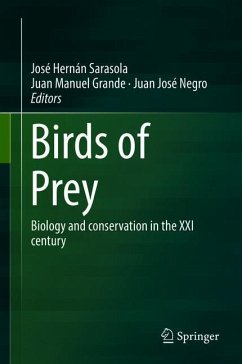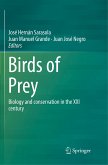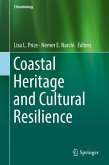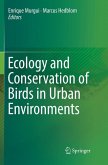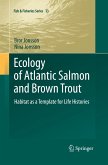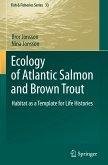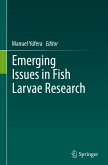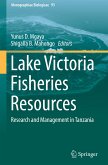Birds of Prey
Biology and conservation in the XXI century
Herausgegeben:Sarasola, José Hernán; Grande, Juan Manuel; Negro, Juan José
Birds of Prey
Biology and conservation in the XXI century
Herausgegeben:Sarasola, José Hernán; Grande, Juan Manuel; Negro, Juan José
- Gebundenes Buch
- Merkliste
- Auf die Merkliste
- Bewerten Bewerten
- Teilen
- Produkt teilen
- Produkterinnerung
- Produkterinnerung
This book will provide the state-of-the-art on most of the topics involved in the ecology and conservation of birds of prey. With chapters authored by the most recognized and prestigious researchers on each of the fields, this book will become an authorized reference volume for raptor biologists and researchers around the world.
Andere Kunden interessierten sich auch für
![Birds of Prey Birds of Prey]() Birds of Prey186,99 €
Birds of Prey186,99 €![Coastal Heritage and Cultural Resilience Coastal Heritage and Cultural Resilience]() Coastal Heritage and Cultural Resilience112,99 €
Coastal Heritage and Cultural Resilience112,99 €![Ecology and Conservation of Birds in Urban Environments Ecology and Conservation of Birds in Urban Environments]() Ecology and Conservation of Birds in Urban Environments176,54 €
Ecology and Conservation of Birds in Urban Environments176,54 €![Ecology of Atlantic Salmon and Brown Trout Ecology of Atlantic Salmon and Brown Trout]() Bror JonssonEcology of Atlantic Salmon and Brown Trout298,99 €
Bror JonssonEcology of Atlantic Salmon and Brown Trout298,99 €![Ecology of Atlantic Salmon and Brown Trout Ecology of Atlantic Salmon and Brown Trout]() Bror JonssonEcology of Atlantic Salmon and Brown Trout298,99 €
Bror JonssonEcology of Atlantic Salmon and Brown Trout298,99 €![Emerging Issues in Fish Larvae Research Emerging Issues in Fish Larvae Research]() Emerging Issues in Fish Larvae Research138,99 €
Emerging Issues in Fish Larvae Research138,99 €![Lake Victoria Fisheries Resources Lake Victoria Fisheries Resources]() Lake Victoria Fisheries Resources75,99 €
Lake Victoria Fisheries Resources75,99 €-
-
-
This book will provide the state-of-the-art on most of the topics involved in the ecology and conservation of birds of prey. With chapters authored by the most recognized and prestigious researchers on each of the fields, this book will become an authorized reference volume for raptor biologists and researchers around the world.
Produktdetails
- Produktdetails
- Verlag: Springer / Springer International Publishing / Springer, Berlin
- Artikelnr. des Verlages: 978-3-319-73744-7
- 1st edition 2018
- Seitenzahl: 532
- Erscheinungstermin: 13. Juli 2018
- Englisch
- Abmessung: 241mm x 160mm x 34mm
- Gewicht: 950g
- ISBN-13: 9783319737447
- ISBN-10: 3319737449
- Artikelnr.: 50238696
- Herstellerkennzeichnung Die Herstellerinformationen sind derzeit nicht verfügbar.
- Verlag: Springer / Springer International Publishing / Springer, Berlin
- Artikelnr. des Verlages: 978-3-319-73744-7
- 1st edition 2018
- Seitenzahl: 532
- Erscheinungstermin: 13. Juli 2018
- Englisch
- Abmessung: 241mm x 160mm x 34mm
- Gewicht: 950g
- ISBN-13: 9783319737447
- ISBN-10: 3319737449
- Artikelnr.: 50238696
- Herstellerkennzeichnung Die Herstellerinformationen sind derzeit nicht verfügbar.
José Hernán Sarasola received his degree in Natural Resources from the National University of La Pampa (UNLPam), Argentina, and earned his Ph.D. in Biology at the University of Seville (Spain) after being granted a doctoral fellowship at the Doñana Biological Station. He is one of the co-founders of the Center for the Study and Conservation of Birds of Prey in Argentina (CECARA) where he has served as vice-director and director. He has conducted field research on a variety of species in South America and Europe focusing on raptor population ecology, migration and conservation. He is a researcher at the National Scientific and Technical Research Council of Argentina (CONICET) and adjunct professor of Ecology at UNLPam. He has been visiting scholar at University of Saskatchewan (Canada) and the Autonomous University of Madrid (Spain). Juan Manuel Grande has a B.S. degree in Biology from the Universidad de Barcelona and Ph.D in Biology from the University of Seville, both in Spain. He's been a postdoc researcher at the University of Saskatchewan, in Canada and is a researcher at the National Scientific and Technical Research Council of Argentina (CONICET). He is vice director of the Center for the Study and Conservation of Raptors in Argentina (CECARA) and professor of Biology at the Universidad Nacional de La Pampa. He has served as Director at Large of the Raptor Research Foundation. His main research interests are linked to birds of prey ecology and the effects of anthropic transformation on natural landscapes on this group of birds. Juan José Negro's research interests focus on evolutionary ecology and conservation of endangered birds of prey. He is an associate editor of 'Animal Biodiversity and Conservation' and the 'Journal of Unmanned Vehicle Systems'. He is also vice-president of the Spanish Society of Ethology and Evolutionary Ecology. Negro graduated from the Faculty of Biology at the University of Sevilla, where he later earned a PhD inBiology. He has been a visiting scholar at CalPoly, California, and Heidelberg University, Germany. He held a postdoc position at McGill University, Canada and was director of Doñana Biological Station. Negro is a professor of research at the Spanish Council for Scientific Research. He received the Hamerstrom Award from The Raptor Research Foundation in recognition of his contributions to the understanding of raptor ecology and natural history.
Section 1 - General biology.- 1 Recent advances in raptor taxonomy and phylogeny.- 2 Breeding and nesting biology.- 3 Population ecology of birds of prey.- 4 Behavioural ecology of raptors.- 5 Raptor migration.- 6 Dispersal in raptors.- Section 2 - Raptors in human landscapes.- 7 Raptors and people: an ancient relationship persisting today.- 8 Conflicts between raptors and humans.- 9 Causes and consequences of urban living in raptors.- 10 Birds of prey in agricultural landscapes, the role of agriculture expansion and intensification.- 11 Toxicology of birds of prey.- 12 Lead contamination in birds of prey.- 13 Raptors electrocutions and power lines collisions.- 14 Impact of renewable energy sources on birds of prey.- 15 Use of drone imagery for research and conservation of birds of prey.- Section 3 - Conservation and status of raptors around the world.- 16 Distribution models for raptor research and conservation.- 17 Conservation genetics in birds of prey.- 18 Conservation statusof Neotropical raptors.- 19 Conservation priorities for raptors across Asia.- 20 Conservation of African raptors.- 21 Conservation status and threats of New World vultures.- 22 Old vultures in a changing environment.- 23 Past, present and future of raptors on islands.- 24 Raptor conservation in practice.
Section 1 - General biology.- 1 Recent advances in raptor taxonomy and phylogeny.- 2 Breeding and nesting biology.- 3 Population ecology of birds of prey.- 4 Behavioural ecology of raptors.- 5 Raptor migration.- 6 Dispersal in raptors.- Section 2 - Raptors in human landscapes.- 7 Raptors and people: an ancient relationship persisting today.- 8 Conflicts between raptors and humans.- 9 Causes and consequences of urban living in raptors.- 10 Birds of prey in agricultural landscapes, the role of agriculture expansion and intensification.- 11 Toxicology of birds of prey.- 12 Lead contamination in birds of prey.- 13 Raptors electrocutions and power lines collisions.- 14 Impact of renewable energy sources on birds of prey.- 15 Use of drone imagery for research and conservation of birds of prey.- Section 3 - Conservation and status of raptors around the world.- 16 Distribution models for raptor research and conservation.- 17 Conservation genetics in birds of prey.- 18 Conservation statusof Neotropical raptors.- 19 Conservation priorities for raptors across Asia.- 20 Conservation of African raptors.- 21 Conservation status and threats of New World vultures.- 22 Old vultures in a changing environment.- 23 Past, present and future of raptors on islands.- 24 Raptor conservation in practice.

